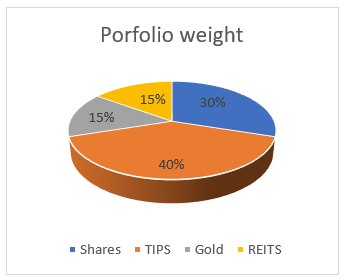Efficient Portfolio With a Combination of Equity and Discusses How the Shares Selected Work Together
Executive summary
This report details the creation of an efficient portfolio with a combination of equity and discusses how the shares selected work together, as well as its implications in terms of its volatility-performance relationship. Assuming that the portfolio had been hold for the last three years, its performance is analysed using some of the most common metrics in the industry. Also, an alternative option is given with a portfolio composed of equity and risk-free US treasury bills. Towards the end, a hedging strategy using put options is used to reduce risk in a portfolio with only one risky security.
1. Asset allocation
For the purposes of the creation of this portfolio, we will avoid cash as it is an asset that depreciates over time as inflation increases. In order to maximise the returns produced by the portfolio, investors should put the money in, at least, treasury inflation protected securities (TIPS), US treasuries which return is equal to the increase of inflation.
Need an essay assistance?
Our professional writers are here to help you.
This is especially true of the current economic environment. Governments and central banks have been executing a number of quantitative easings to ameliorate the negative effects of 2008 recession and the Covid-19 pandemic over the economy. One of the side effects of this monetary policy practice is that it comes with spikes in inflation. TIPS should help hedge against this.
Having said this, the objective of the investors at the hedge fund would obviously be to make up a portfolio with a combination of assets that would perform better than the market benchmark (FTSE 100 index) in all kinds of environments and situations. If the benchmark goes up by 10%, the portfolio in question should go higher. If the benchmark drops by 10%, this should have a minimal impact on the portfolio – all of this of course with reduced risk.
According to what it has been stated above, it is advisable to invest the £1M of capital in a portfolio that resembles the following chart.

- Equity £300,000
- TIPS £400,000
- Gold £150,000
- REITS £150,000
£1,000,000
1.1 Gold
Gold has established itself as a kind of “anti-money”. It is seen as the opposite of the euro or the US dollar, which are fiat currencies. The fact that gold is limited makes it so interesting and valuable. Fiat currencies, on the other hand, are theoretically unlimited. The amount of gold (spot market) only increases by about 1.5% every year. However, it is safe to say that this figure will decrease over the years as the amount of this commodity in underground reserves dries up by 1.5% per year due to mining.
The demand for gold has remained stable over the years. This is due, for example, to the electrical, medical and jewelry industries, which account for about 60% of demand. The remaining 40% is filled by speculators and investors. The demand for the precious metal is what drives the price. Gold is considered a real asset in the financial industry.
The dynamics between supply and demand describe the value as stable over the long term. On the one hand, an investment in the precious metal offers the opportunity to speculate with its value. For example, the central banks increase the money supply or other factors, which leads to hyperinflation. Especially here it is worthwhile to hedge against the market in order to hedge its risk with gold. Since gold has often shown a negative correlation with stock market returns since the 1970s, owning gold is seen as a hedge against market volatility (Van Hoang, Lahiani & Heller, 2016), depending on the circumstances (see risk hedge matrix further below). Investing in gold is considered a kind of safe decision, as gold is popularly regarded as a haven.
1.2 Treasury inflation protected securities (TIPS)
This type of US treasury has a significant share in this portfolio. The reason for the 40% weight in these is that bonds are also considered to be a kind of haven. They are especially attractive to investors who are trying to minimize their portfolio risk and lower the overall volatility due to their low-risk characteristics. If you look at bonds over the course of a long-term investment over the past 20 years, their annual return is just 5.5%. However, the current economic landscape suggests that we are about to experience a spike in inflation (due to increases in the money supply), which should preserve the value
Order this paper